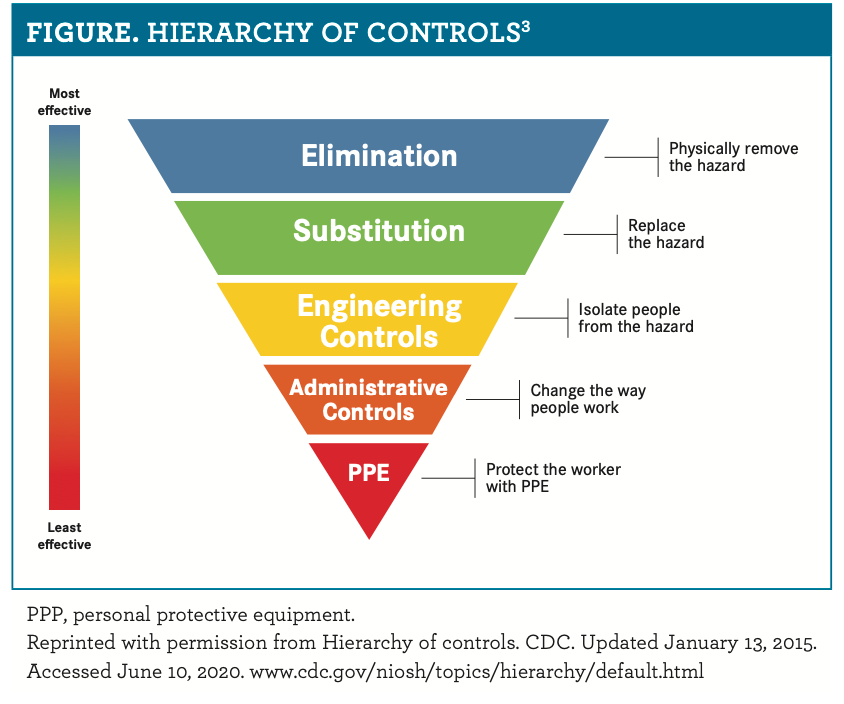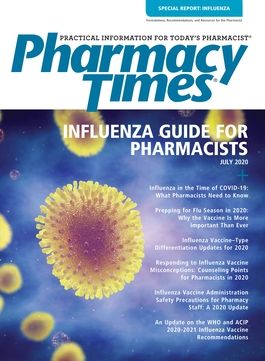Publication
Article
Supplements
Influenza Vaccine Administration Safety Precautions for Pharmacy Staff: A 2020 Update
Author(s):
As people wait for the development of a vaccine for COVID-19, they may consider the need for other vaccinations as well.
The coronavirus disease 2019 (COVID-19) pandemic has brought many changes to the daily lives of people all over the world. Safety is the driving force behind most of these changes, which were made to decrease the spread of COVID-19. People are practicing social distancing, schools have moved to online learning, and businesses are finding new ways to operate to keep their communities safe. Pharmacies have made changes such as delivering medications to customers, requiring staff to wear masks, and stepping up cleaning and sanitation procedures.1 During this pandemic, patients may be more understanding of changes being made in the pharmacy, given the reasoning behind them.
Vaccines have been a hot topic during this time. As people wait for the development of a vaccine for COVID-19, they may consider the need for other vaccinations as well. Due to this increased awareness, there may be a substantial increase in demand for the influenza (flu) vaccine this upcoming season.2 Administering vaccines brings pharmacists in close contact with their patients. Safety becomes an even bigger focus in such an intimate setting, and pharmacists need to plan for flu shot season. Establishing proper controls and protections and using appropriate personal protective equipment (PPE) should be part of every pharmacist’s plan to keep themselves, their staff, and patients as safe as possible.1 This article provides an overview of changes that pharmacists may wish to consider implementing in their pharmacies.
CONTROLS
Controls are methods that can be used to help protect health care professionals from a specific hazard or danger. The figure3 shows the hierarchy of controls that can be used. The most effective controls are at the widest part of the inverted pyramid and the least effective controls are at the apex. In our discussion, COVID-19 is the hazard, and we will discuss the hierarchy of controls in this context.
- Elimination and substitution are not applicable with regard to COVID-19, as exposure to asymptomatic carriers when in public spaces cannot be eliminated or avoided.3
- Engineering controls, or the use of physical barriers to reduce exposure, are the most effective control strategies with regard to COVID-19. The presence of plastic windows at the pharmacy counter is an example of a good engineering control. Pharmacists should consider others controls that can be used in waiting rooms or immunization areas to help protect pharmacists and patients.1,3
- Administrative controls are things done by per- sonnel intentionally for protection. Examples include cleaning, keeping a distance between individuals, and making sure plastic barriers are spoken through instead of being talked around or over.1,3
- PPE is at the bottom of the pyramid, which may come as a surprise. PPE is very important but it must be used properly; thus, it is less dependable as a control compared with other strategies that are not as dependent on proper use. Staff members must wear PPE consistently, avoid contamination, and ensure a correct fit for the highest level of effectiveness.3
PROTECTIONS
Putting protections in place and implementing best practices ahead of flu shot season can help pharmacy staff be as prepared as possible. It is not known at this time where the country will be concerning social distancing when the season comes around. Assume the status quo and adjust as needed. Protection strategies include minimizing personal contact, ensuring that all staff receive training, and maintaining appropriate staffing levels.4 The table shows areas where changes need to be made to reduce contact and strategies for implementing them.1,4
Maintain appropriate staffing levels and ensure all staff members receive training on safety procedures.4 Check with your state’s board of pharmacy to see if technicians can be trained to administer immunizations. During the busiest months, it may be helpful to hire a new staff member or cross-train an employee from another part of the store to help. Make sure all pharmacy personnel are on the same page with workflow and safety procedures. Be firm with policies and enforce them in all situations.


PPE
Pharmacies across the country are now using more PPE than ever before. Wearing masks and gloves has become standard practice for most employees. Now is the time to consider what kinds of PPE should be used during immunizations and work to ensure there is an adequate supply of PPE available.
- All immunizers should wear a mask when administering vaccinations; however, that may not provide sufficient protection. Full face shields or removable goggles could also be considered.3,5
- Prescription eyeglasses are open at the sides and thus may not offer enough protection for the eyes. If eye protection is to be worn, it should be in the form of wraparound goggles.5
- Gloves should be worn throughout the preparation and administration process and should be changed after each patient.6
Pharmacists should start ordering extra PPE now. With masks and gloves being in short supply in some areas, it is not too early to begin preparing. The CDC has a burn rate calculator that can be used to estimate how much PPE will be needed.3,7 Ask district managers or clinical personnel what their plan is and urge them to stay aware of demand in order to properly supply the pharmacy when need be. A decision must be made regarding whether patients will be required to wear a mask when receiving a vaccine. If they are required to do so, pharmacies should consider whether they will be able to obtain enough masks to provide them to patients who arrive at the pharmacy without one.
To maximize protection, PPE must be used correctly. All staff should be trained on the proper donning and doffing of masks and other equipment. Proper seals should be maintained on masks and goggles.7,8 Masks should cover the mouth and nose fully, extending under the chin.8 Gloves should fit properly and cover the cuff of sleeves.8 Safeguards to prevent contamination must be reinforced to avoid wasting valuable PPE. Any PPE that is suspected to have been contaminated should either be thrown away or sanitized properly.5,9
CONCLUSIONS
The 2020-2021 flu season could be one for the ages. Concerns about COVID-19 and increased awareness about the need for vaccinations may push demand for flu shots to record levels. Pharmacists should develop a plan to handle crowds and high demand. Patients and staff are extremely concerned about safety, which will only add to the challenges. Safety needs to be the highest priority for vaccine administrators so they are able to stay healthy and virus free, especially during this time of great need. Most importantly, each pharmacist should be sure they are taking care of their own safety. Waiting for or expecting someone else to do it may not result in the desired outcome.
REFERENCES
1. Guidance for pharmacies. CDC. Updated June 28, 2020. Accessed June 29, 2020. www.cdc.gov/coronavirus/2019-ncov/hcp/pharmacies.html
2. Humer C, Steenhuysen J. Fears of coronavirus second wave prompt flu push at U.S. pharmacies, drugmakers. Reuters. May 26, 2020. Accessed June 29, 2020. www.reuters.com/article/us-health-coronavirus-flu-focus/fears-of-coronavirus- second-wave-prompt-flu-push-at-u-s-pharmacies-drugmakers-idUSKBN2321F0
3. Hierarchy of controls. CDC. Updated January 13, 2015. Accessed June 10, 2020. www.cdc.gov/niosh/topics/hierarchy/default.html
4. Interim guidance for businesses and employers responding to coronavirus disease 2019 (COVID-19), May 2020. CDC. Updated May 6, 2020. Accessed June 29, 2020. www.cdc.gov/coronavirus/2019-ncov/community/guidance-busi- ness-response.html
5. Strategies for optimizing the supply of eye protection. CDC. Updated June 28, 2020. Accessed June 29, 2020. www.cdc.gov/coronavirus/2019-ncov/hcp/ ppe-strategy/eye-protection.html
6. Transmission-based precautions. CDC. Updated January 7, 2016. Accessed June 29, 2020. www.cdc.gov/infectioncontrol/basics/transmission-based-precau- tions.html
7. Personal protective equipment (PPE) burn rate calculator. CDC. Updated April 7, 2020. Accessed June 29, 2020. www.cdc.gov/coronavirus/2019-ncov/ hcp/ppe-strategy/burn-calculator.html
8. Using personal protective equipment. CDC. Updated June 11, 2020. Accessed June 29, 2020. www.cdc.gov/coronavirus/2019-ncov/hcp/using-ppe.html
9. Strategies for optimizing the supply of disposable medical gloves. CDC. Updated April 30, 2020. Accessed June 29, 2020. www.cdc.gov/coronavi- rus/2019-ncov/hcp/ppe-strategy/gloves.html







